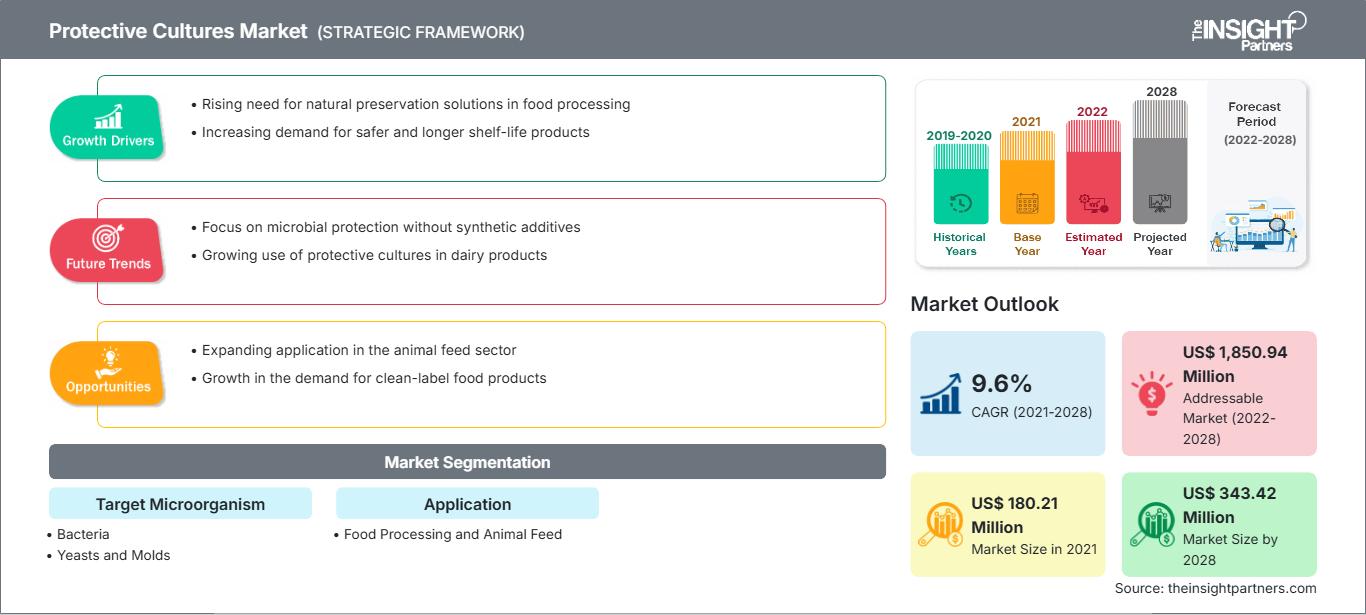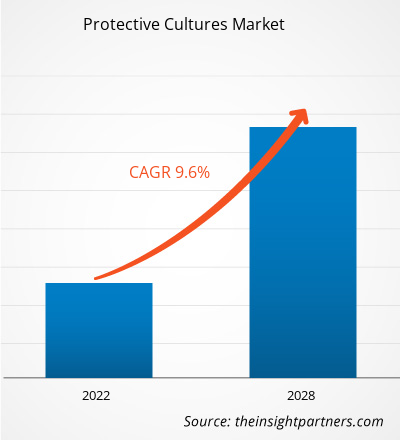[Rapporto di ricerca]Si prevede che il mercato delle colture protettive crescerà da 180,21 milioni di dollari nel 2021 a 343,42 milioni di dollari entro il 2028; si stima una crescita a un CAGR del 9,6% dal 2021 al 2028.
La crescente domanda di prodotti naturali e senza conservanti chimici e la crescente domanda di prodotti deperibili con una lunga durata di conservazione in tutto il mondo guidano la crescita del mercato delle colture protettive.
Si prevede che il mercato delle colture protettive nell'area Asia-Pacifico crescerà al CAGR più elevato durante il periodo di previsione. La Cina è il mercato lattiero-caseario più importante ed è trainata principalmente dal crescente consumo di prodotti lattiero-caseari. La crescente domanda di prodotti lattiero-caseari come snack naturali, prodotti lattiero-caseari fermentati come il latte acido e lo yogurt, unita alle innovazioni di prodotto e packaging, sta trainando la crescita del mercato lattiero-caseario nell'area Asia-Pacifico. Pertanto, si prevede che il mercato delle colture protettive registrerà una crescita significativa nei prossimi anni, grazie al crescente consumo di prodotti lattiero-caseari e ai benefici delle colture protettive, come la capacità di inibire la crescita di microrganismi patogeni e alteranti. Inoltre, la crescente consapevolezza dei prodotti naturali e a marchio pulito tra la popolazione asiatica sta contribuendo all'espansione del mercato.
Personalizza questo rapporto in base alle tue esigenze
Potrai personalizzare gratuitamente qualsiasi rapporto, comprese parti di questo rapporto, o analisi a livello di paese, pacchetto dati Excel, oltre a usufruire di grandi offerte e sconti per start-up e università
Mercato delle colture protettive: Approfondimenti strategici

-
Ottieni le principali tendenze chiave del mercato di questo rapporto.Questo campione GRATUITO includerà l'analisi dei dati, che vanno dalle tendenze di mercato alle stime e alle previsioni.
Impatto della pandemia di COVID-19 sul mercato delle colture protettive
L'attuale pandemia di COVID-19 ha avuto un impatto relativamente positivo sul mercato delle colture protettive. La pandemia ha contribuito a sviluppare interesse e consapevolezza nei confronti delle colture microbiche. La crisi è stata un periodo spiacevole e stressante per la maggior parte della popolazione mondiale. Pertanto, le persone in tutto il mondo hanno iniziato a consumare prodotti a etichetta pulita. Dopo l'avvento della pandemia di COVID-19, le persone sono diventate più caute riguardo al cibo e consumano cibi più sani rispetto alla dieta abituale. La pandemia di COVID-19 ha cambiato la percezione del consumatore di "clean beyond label" (letteralmente "pulito"), al di là delle etichette o dei prodotti. I consumatori continuano a concentrarsi sulle etichette pulite sia per gli acquisti domestici che per quelli fuori casa, il che sta aumentando l'applicazione delle etichette pulite nelle varie applicazioni alimentari. Inoltre, le prospettive di progresso economico nella maggior parte dei paesi sono ottimistiche per il 2021.
Approfondimenti di mercato
Consumo crescente di prodotti lattiero-caseari
Il mercato lattiero-caseario si sta evolvendo in tutto il mondo. I consumatori preferiscono prodotti lattiero-caseari più salutari, naturali e sostenibili, con elenchi di ingredienti più brevi e una maggiore trasparenza sull'etichettatura dei prodotti. Con gli stili di vita moderni sempre più frenetici, cresce la domanda di opzioni pratiche che possano essere consumate in movimento senza dover essere refrigerate per mantenerle fresche. Le colture protettive sono fondamentali per supportare i produttori lattiero-caseari nell'aumentare i profitti evitando il deterioramento durante la conservazione, soddisfacendo così l'esigenza dei consumatori di prodotti naturali e con etichette pulite. Inoltre, il consumo di prodotti lattiero-caseari, come yogurt, burro e formaggio, è in forte crescita in tutto il mondo.
Il formaggio è diventato un ingrediente primario nelle diete quotidiane in tutto il mondo. Secondo il Dipartimento dell'Agricoltura degli Stati Uniti, nel 2017 sono state prodotte 5.733 tonnellate di formaggio nel Paese e la popolazione nordamericana ne consuma in media circa 6.626 tonnellate all'anno. Il mercato del formaggio è anche uno dei principali utilizzatori finali di colture protettive, grazie alla coltura protettiva specifica utilizzata contro la Listeria. È prodotta con Lactobacillus plantarum ed è efficace nel prevenire la formazione di Listeria sui formaggi ad alto rischio di stagionatura con striscio rosso superficiale. Da qui in poi, questi fattori guidano la domanda di formaggio nel mercato delle colture protettive. Inoltre, aziende come DuPont Danisco e Chr. Hansen hanno una presenza significativa nel mercato dei prodotti lattiero-caseari con un'ampia gamma di colture protettive. Con la crescente domanda di prodotti lattiero-caseari naturali e salutari, i prodotti a marchio pulito e a marchio verde stanno registrando un'enorme domanda nel settore lattiero-caseario.
Approfondimenti sui microrganismi bersaglio
In base al microrganismo bersaglio, il mercato delle colture protettive si divide in batteri, lieviti e muffe. Il segmento dei lieviti e delle muffe ha rappresentato una quota di mercato maggiore nel 2020. I lieviti sono un sottoinsieme dei funghi, un ampio gruppo di organismi che include anche muffe e funghi. Sono tipicamente organismi unicellulari che si sono evoluti per vivere in ambienti specializzati. Il lievito colonizza tipicamente alimenti ad alto contenuto di sale o zucchero, come sottaceti, sciroppo d'acero e altri, contribuendo al loro deterioramento. Frutta e liquidi con un pH basso sono altri bersagli, e alcuni lieviti si sviluppano sulla superficie di carne e formaggio. Le muffe sono composte da milioni di cellule microscopiche collegate tra loro a formare catene e si trovano su pane, frutta, carta umida e altre superfici. Possono rovinare alimenti secchi, pesce salato, frutta, gelatine, pane, sottaceti, marmellate e altri prodotti simili.
Approfondimenti sulle applicazioni
In base all'applicazione, il mercato delle colture protettive si divide in trasformazione alimentare e mangimi. Il segmento della trasformazione alimentare ha rappresentato una quota di mercato maggiore nel 2020, mentre si prevede che il segmento dei mangimi registrerà un CAGR più elevato nel mercato durante il periodo di previsione. La trasformazione alimentare comprende vari settori come i prodotti lattiero-caseari, le bevande e i prodotti a base di carne, pollame e pesce. L'uso di colture protettive è crescente, soprattutto nei settori lattiero-caseario, della carne e dei frutti di mare, poiché sono generalmente riconosciute come sicure (GRAS) per il consumo e predominano naturalmente nel microbiota di molti alimenti. Inoltre, a causa della necessità di prodotti con una maggiore durata di conservazione, le aziende di trasformazione alimentare utilizzano sempre più colture protettive. Inoltre, i consumatori stanno diventando consapevoli del fatto che una grande quantità di spreco alimentare è causata dal deterioramento e dalla crescita di muffe. Ciò influisce anche sulla redditività delle aziende di trasformazione alimentare; pertanto, le aziende utilizzano colture protettive per ridurre gli sprechi alimentari. Pertanto, la domanda di questi prodotti nell'industria alimentare è in aumento. Le colture protettive sono fondamentali per aiutare i produttori lattiero-caseari a migliorare i loro prodotti evitando il deterioramento durante tutta la shelf life, prolungando la durata di conservazione e soddisfacendo al contempo la domanda dei consumatori di prodotti naturali e più puliti.
Alcuni attori che operano nel mercato delle colture protettive sono Biochem Srl, Bioprox, Chr. Hansen Holding A/S, Meat Cracks Technologie GmbH, DSM, Lallemand Inc., International Flavors & Fragrances Inc., Kerry Group, Sacco System e Dalton Biotechnologies Srl Le aziende chiave adottano strategie come fusioni e acquisizioni, ricerca e sviluppo per espandere la base clienti e ottenere una quota significativa nel mercato globale, il che consente loro anche di mantenere il proprio marchio a livello globale.
Approfondimenti regionali sul mercato delle culture protettive
Le tendenze regionali e i fattori che influenzano il mercato delle colture protettive durante il periodo di previsione sono stati ampiamente spiegati dagli analisti di The Insight Partners. Questa sezione illustra anche i segmenti e la geografia del mercato delle colture protettive in Nord America, Europa, Asia-Pacifico, Medio Oriente e Africa, America Meridionale e Centrale.
Ambito del rapporto di mercato sulle culture protettive
| Attributo del rapporto | Dettagli |
|---|---|
| Dimensioni del mercato in 2021 | US$ 180.21 Million |
| Dimensioni del mercato per 2028 | US$ 343.42 Million |
| CAGR globale (2021 - 2028) | 9.6% |
| Dati storici | 2019-2020 |
| Periodo di previsione | 2022-2028 |
| Segmenti coperti |
By Microrganismo bersaglio
|
| Regioni e paesi coperti |
Nord America
|
| Leader di mercato e profili aziendali chiave |
|
Densità degli attori del mercato delle culture protettive: comprendere il suo impatto sulle dinamiche aziendali
Il mercato delle colture protettive è in rapida crescita, trainato dalla crescente domanda degli utenti finali, dovuta a fattori quali l'evoluzione delle preferenze dei consumatori, i progressi tecnologici e una maggiore consapevolezza dei benefici del prodotto. Con l'aumento della domanda, le aziende stanno ampliando la propria offerta, innovando per soddisfare le esigenze dei consumatori e sfruttando le tendenze emergenti, alimentando ulteriormente la crescita del mercato.

- Ottieni il Mercato delle colture protettive Panoramica dei principali attori chiave
In evidenza nel rapporto
- Tendenze progressive del settore nel mercato delle colture protettive per aiutare gli operatori a sviluppare strategie efficaci a lungo termine
- Strategie di crescita aziendale adottate dai mercati sviluppati e in via di sviluppo
- Analisi quantitativa del mercato delle colture protettive dal 2019 al 2028
- Stima della domanda globale di colture protettive
- Analisi delle cinque forze di Porter
- Sviluppi recenti per comprendere lo scenario del mercato competitivo
- Tendenze e prospettive di mercato, nonché fattori che guidano e frenano la crescita del mercato delle colture protettive
- Assistenza nel processo decisionale evidenziando le strategie di mercato che sostengono l'interesse commerciale, portando alla crescita del mercato
- Dimensioni del mercato delle colture protettive in vari nodi
- Panoramica dettagliata e segmentazione del mercato, così come le dinamiche del settore delle colture protettive
- Dimensioni del mercato delle colture protettive in varie regioni con promettenti opportunità di crescita
Mercato delle colture protettive - per microrganismo target
- Batteri
- Lievito e muffa
Mercato delle colture protettive - per applicazione
- Lavorazione alimentare
- Latticini
- Bevande
- Carne, pollame e prodotti ittici
- Altri
- Mangimi per animali
Profili aziendali
- Biochem Srl
- Bioprox
- Chr. Hansen Holding A/S
- Meat Cracks Technologie GmbH
- DSM
- Lallemand Inc.
- Sapori internazionali e amp; Fragrances Inc.
- Gruppo Kerry
- Sacco System
- Dalton Biotechnologies Srl
- Analisi storica (2 anni), anno base, previsione (7 anni) con CAGR
- Analisi PEST e SWOT
- Valore/volume delle dimensioni del mercato - Globale, Regionale, Nazionale
- Industria e panorama competitivo
- Set di dati Excel
Report recenti
Testimonianze
Motivo dell'acquisto
- Processo decisionale informato
- Comprensione delle dinamiche di mercato
- Analisi competitiva
- Analisi dei clienti
- Previsioni di mercato
- Mitigazione del rischio
- Pianificazione strategica
- Giustificazione degli investimenti
- Identificazione dei mercati emergenti
- Miglioramento delle strategie di marketing
- Aumento dell'efficienza operativa
- Allineamento alle tendenze normative






















 Ottieni un campione gratuito per - Mercato delle colture protettive
Ottieni un campione gratuito per - Mercato delle colture protettive